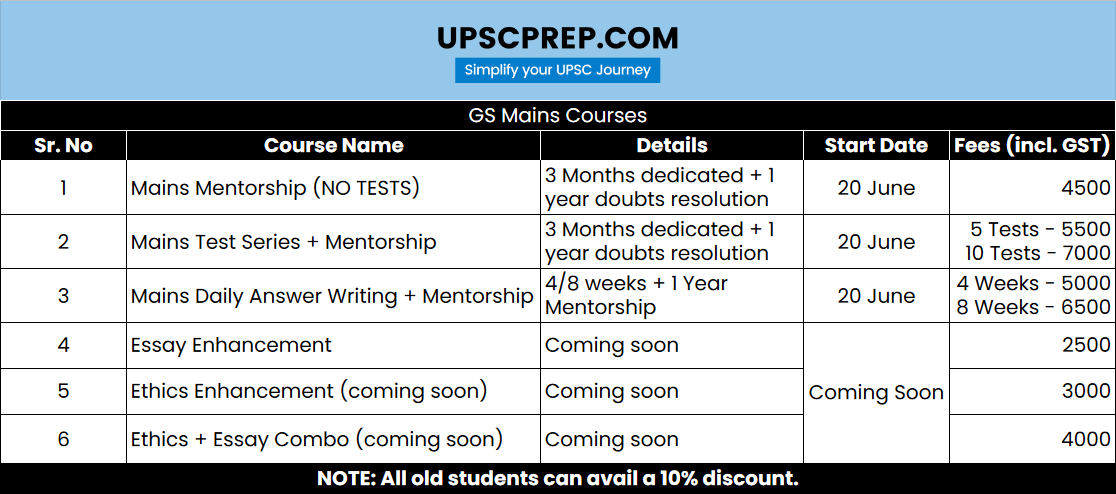Questions
Model Solutions
Want to get these answers evaluated?

1. What are the use cases for blockchain technology in governance? What are their advantages and limitations? (15 marks)
2. Food poverty is lacking the means to obtain enough food to live a healthy life. Critically examine the measures taken by the government to address food poverty in India. (15 marks)
Model Structure 1.
Introduction
● Blockchain technology is a technology that leads to a chain of blocks, containing digital information stored in a public database. It is a distributed database existing on multiple computers at the same time, which constantly grows as new sets of recordings or blocks are added to it
Main Body
● Possible use cases in Governance
○ Governance: Blockchain technology can help in ensuring good governance. It ensures transparency of the public records through the usage of a digital form platform and allows auditing of government documents. Moreover it allows to maintain the authenticity of the document and clearly reduces the processing time.
○ Banking: Blockchain can help in avoiding risk of payment losses involved in banking transactions by adopting secure distributed ledger platform. It reduces transaction fees across cross-borders, corporate payments and remittances.
○ Food & Supply Chain: It creates a tamper proof record to check the real information about expiration date, product journey from the farm to the shop. The real information of the product can help in improving the reliability and efficiency of the supply chain system.
○ Insurance: Blockchain technology can change the ways the insurance documents, claim settlements and fraud handling are carried out. It allows the creation of a transparent, secure, decentralized and immutable insurance network.
○ Healthcare: It helps to prioritize patient health at all costs without compromising the quality of the health care service. By establishing a secure chain of networks, blockchain can help in handling the patient records, consent forms, billings and public health monitoring.
○ Automotive: Blockchain can solve the challenges in automotive manufacturing, car deliveries, billings. It can help in the creation of an after sales support ecosystem to keep track of the maintenance record of vehicle owners.
○ Tourism: Blockchain can reduce the delay time of passenger document handling, creates a decentralized hotel booking ecosystem at the least transaction fee and also keeps passengers private information safe.
● Advantages
○ Integrity of the whole process - any block or even a transaction that adds to the chain cannot be edited
○ Traceability: With the blockchain ledger, each time an exchange of goods is recorded on a Blockchain, an audit trail is present to trace where the goods came from. This improves security and prevents fraud in exchange-related businesses.
○ Security: Blockchain is considered to be a highly secure system due to its digital signature and encryption
○ Faster processing: Before the invention of the blockchain, the traditional banking organisation took a lot of time in processing and initiating the transaction but after the blockchain technology speed of the transaction increased to a very high extent.
○ Fraud prevention: A system that is based on data stored in a number of places is immune to hackers. It's not that easy to get access to it, and if so, any piece of information can be easily recovered
○ Transparency - due to distributed ledger
● Limitations
○ Huge power required to verify transactions.
○ Technological Challenges – The technological infrastructure of the country and the lack of technical awareness is one of the biggest challenges
○ Storage – Data stored in the Blockchain cannot be modified. This demands very heavy resources in terms of storage and may become an issue as the chain of blocks grow
○ Skillset and Awareness Issues – Manpower who knows both Domain & Technology is required for blockchain technology management, which may be challenging to find ○ Security, Privacy and Regulation – Blockchain data is stored on every node on the network and hence privacy is not an inherent feature
○ Legal Challenges – Thee Reserve Bank of India has put forth restriction with respect to virtual currencies based on Blockchain technology and there is a circular to halt the usage of crypto-currency transactions in India
Model Structure 2.
Introduction
● People living in food poverty have an income or expenditure that is less than the amount needed to consistently afford a basket of food with minimum recommended nutritional intake.
Main Body
● Situation of food poverty in India
○ According to UN-India, there are nearly 195 million undernourished people in India, which is a quarter of the world’s hunger burden.
● Article 47 of the Constitution of India states that it is the duty of the State to raise the level of nutrition and the standard of living and to improve public health.
● Measures taken by the government ○ National food security Act
○ Mid-day Meal Programme,
○ ICDS,
○ Kishori Shakti Yojana,
○ Nutrition programme for Adolescent Girls
○ Pradhan Mantri Gramodaya Yojana,
○ Antyodaya Anna Yojana (AAY)
● Limitations
○ Issue of Hidden hunger (Nutritional security) is not addressed through sufficiently through these programmes
○ Inadequate distribution of food through public distribution mechanisms (PDS i.e. Public Distribution System)
○ Quality issue: Low quality of grains and the poor service at PDS shops
○ Inefficient implementation of government schemes and programmers
○ Lack of coherent food and nutrition policies along with the absence of intersectoral coordination between various ministries of government such as Ministry of Women and Child Health, Ministry of Health and Family Welfare, Ministry of Agriculture, Ministry of Finance etc have added to the problem.
● Way Forward
○ Implementing measures to improve agricultural productivity and food storage
○ Ensuring food availability & accessibility to below poverty line (BPL) candidates
○ The Public Distribution System must be made transparent and reliable.
○ Improving purchasing power through employment generating schemes
- The government should come up with more holistic schemes like Mahatma Gandhi National Rural Employment Guarantee Act (MGNREGA).
○ Crop diversification, establishing food grain banks & promoting household gardening
○ Community awareness through IEC activities and social marketing
○ Monitoring and timely evaluation of nutritional programmes
Conclusion
● India needs to adopt a policy that brings together diverse issues such as inequality, food diversity, indigenous rights and environmental justice to ensure sustainable food security
Previous Post
